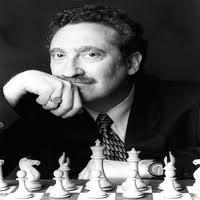
Pandolfini's Puzzler #23 - Is the Board Half Full or Half Empty?
Professor: We know there are 64 squares on a chessboard. We also know there are 32 light squares and 32 dark ones. Now let’s talk material. How many pieces does a player start the game with?
---
Lucian: It depends what you mean by pieces.
---
Professor: Oh? Is there some confusion about the term “piece”?
---
Zephyr: Actually, there is. If you’re an ordinary person, and you know very little about chess, you’ll probably say that White starts a game with 16 pieces.
---
Lucian: That’s right. You’ll count pawns as being pieces, and real chess players don’t do that. They don’t see 16 pieces, the way non-chess players do. They see only 8 pieces, along with 8 pawns.
---
Zephyr: But Professor, if we don’t call pawns "pieces," what should we call them when talking about all the pawns and pieces together?
---
Professor: I like to refer to them as “units.” Accordingly, White starts the game with 16 units, and, of course, so does Black.
---
Lucian: But there are 16 pieces on the board at the start. White has eight and Black has eight.
---
Professor: That’s right. But let me ask you a question. At the start of a game, which space is greater: the number of occupied squares or the number of empty ones?
---
Zephyr: Professor, that’s too easy. It’s a tie. Half the board is occupied, and half the board is unoccupied.
---
Professor: Very good. Still, I give you many problems with all 32 units on the board. Even though 32 is a nice binary number, let me make the whole thing easier. Let’s take away 16 units.
---
Lucian: Having fewer units on the board doesn’t mean a problem is easier, Professor.
---
Zephyr: I agree with Lucian. Sometimes having lots of space can lead to greater complications.
---
Lucian: Besides, what do you mean by a binary number?
---
Professor: I was afraid you might ask about that. For the purpose of this discussion, a binary number is a number based on multiples of the number 2. Therefore, 8 (the number of pieces each side starts a game with) is a binary number. It’s “2” times “2” times “2,” or “2” cubed. You could also say it’s 2 to the 3rd power.
---
Zephyr: I get it. So 16 is also a binary number. It’s “2” times “2” times “2” times “2.”
---
Professor: Or 2 to the 4th power.
---
Lucian: So the next multiple of 2 is 32, and that’s a binary number, which is 2 to the 5th power. And 64 is a binary number. It’s 2 to the 6th power, or “2” times “2” times “2” times “2” times “2” times “2.” That could go on forever.
---
Professor: Yes, but not on the chessboard.
---
Zephyr: Wow, the chessboard is a small binary universe.
---
Professor: Enough binary talk. Let’s move on – not to computers – but to today’s position.
--
---
Professor: As you can see, it has only the original white setup. There are no black units. So let’s put one on the board, and answer the following question.
---
Question: Can you place the black king on the board so that White could then mate in three moves?
---
Zephyr: You mean, we have to do two things. We have to first place the black king back on the board?
---
Lucian: And two, we have to then mate in three moves?
---
Professor: You’re both right. Now it’s time to do both tasks.
---
Since they were in a binary state of mind, it took Zephyr and Lucian about 16 minutes to find the answer. Let’s see how long it takes you.
---
Answers below - Try to solve Professor Pando's puzzle first!
---
ANSWER #23
---
The right square for the black king to be on is h4.
---
---
Mate then follows after 1. d4.
---
If Black then plays 1…Kg4, White does the trick by 2. e4+ Kh4 3. g3 mate.
---
If Black instead tries 1…Kh5, then White wins with 2. Qd3.
---
If Black then answers 2…Kh4, White has 3.Qh3 mate;
---
and if Black instead tries 2…Kg4, the same 3. Qh3 is also mate.
---
Take note
---
The above problem, like so many similar tasks, was originally worked out by the great Sam Loyd. Although Loyd was famous for his chess problems, he also created many mathematical and logical puzzles having nothing to do with chess. Perhaps his most famous is the 14-15 puzzle, where a square block has 15 tiles and one space. The task of the puzzle solver is to rearrange the mixed up tiles in proper order. Loyd made a lot of money on that very popular puzzle, with the 15 and 14 manufactured in reverse order. The public didn’t know that the proper sequence, with all 15 tiles in order, could not be achieved!
RELATED STUDY MATERIAL
- There was a lot of math in this article. Read how (now GM) Bryan Smith got his start in chess, in math class!
- If you like other "weirdo" mates, try these on for size;
- ProfessorPando's final mate is a Crisscross mate - solve more of those here!






